Cooking
The Unexpected Link Between Personality Types and Condiment Preferences
Flavor preferences reveal intriguing insights about your personality, but what does your go-to condiment truly say about you? Discover the surprising connections.
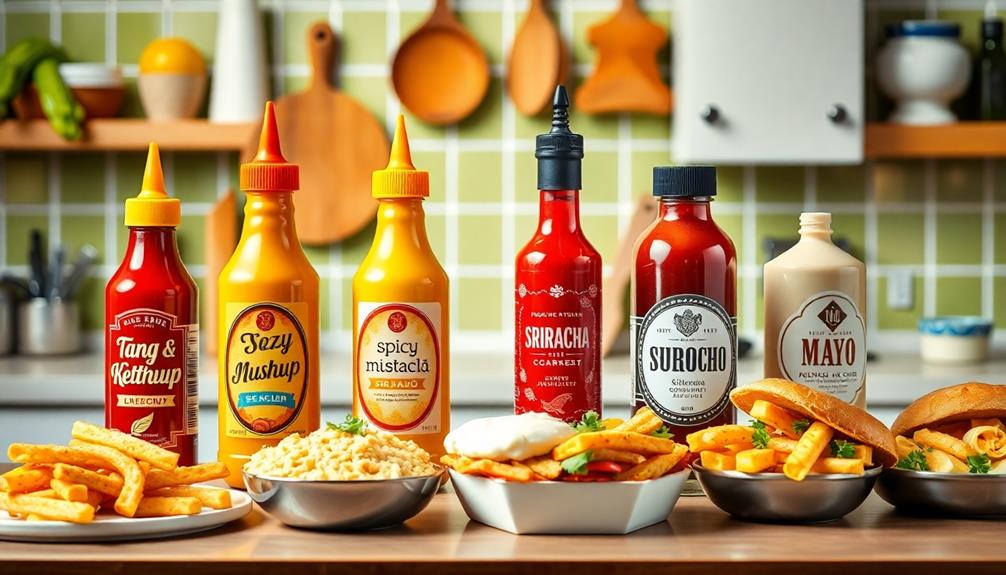
Your condiment choices reveal more about your personality than you might think. People with bold, adventurous personalities often gravitate towards spicy sauces, while those who feel anxious may stick to milder options like ketchup. Extroverts usually enjoy vibrant flavors, whereas introverts prefer subtle tastes. Cultural background and emotional connections also shape your preferences. This link between personality and condiments reflects deeper psychological factors that influence your dietary choices. So, next time you reach for that sauce, consider what it might say about you—there's a lot more to uncover in this flavorful exploration.
Key Takeaways
- Personality traits influence condiment preferences, with sensation seekers favoring bold flavors and anxious individuals opting for mild options.
- Extroverts tend to enjoy spicier condiments, while introverts prefer more subtle tastes.
- Cultural background significantly shapes condiment choices, reflecting regional culinary traditions and family influences.
- Taste preferences can impact mood, with sweet flavors enhancing social connections and romantic feelings.
- Emotional connections to condiments often stem from nostalgia and shared experiences, affecting individual dietary habits.
Personality and Taste Perception

When it comes to your taste preferences, personality plays a surprisingly significant role. If you find yourself drawn to bold flavors and spicy condiments, you might be a sensation seeker or someone who's open to novel experiences. These personality traits often lead to adventurous food choices, like experimenting with different sauces and spices that excite your palate.
For instance, those who enjoy dishes like Cumin Lamb may be more inclined to seek out robust flavors and aromatic condiments.
On the other hand, if you're more anxious or exhibit higher levels of neuroticism, your condiment preferences may lean towards the familiar and mild. You might prefer sweet condiments like ketchup or honey, favoring their comforting taste over more intense options.
This shows how individuals with a more disinhibited personality tend to embrace daring flavors, while anxious types often stick to what they know.
Research suggests that your sensitivity to basic tastes can also shape these preferences. Those who enjoy diverse flavor experiences may find themselves exploring an array of condiments, while others may shy away from anything too bold.
Understanding these links between personality traits and taste preferences can help you make more informed food choices and discover new flavor combinations that resonate with your unique personality.
Neuroscience of Flavor Preferences

When you think about your flavor choices, it's fascinating to contemplate how your personality might shape those preferences.
Neuroscience shows that the neural pathways involved in taste interact with personality traits, influencing whether you crave bold or subtle flavors.
For instance, individuals who enjoy vibrant flavors may be drawn to the rich spices and herbs found in dishes like Caldeirada, while those with a more subdued palate might prefer the sweetness of a simple dessert like Brigadeiro.
Neural Basis of Preferences
Neuroscience reveals fascinating insights into how our brains shape condiment preferences, linking them to personality traits through variations in neurotransmitter levels. Research shows that individuals with high sensation-seeking tendencies often experience heightened dopamine activity, leading to a stronger attraction to spicy and intense condiments. This response indicates that your brain's reward system is uniquely wired to react to specific flavors.
For example, those who enjoy bold flavors may be drawn to dishes like Chicken Chettinad that feature rich, spicy profiles.
The gustatory cortex plays an essential role in processing taste, influencing not just the basic qualities of flavor but also the emotional aspects tied to your preferences. Neuroimaging studies have pinpointed key brain regions, such as the insula and orbitofrontal cortex, which activate during taste perception.
These areas help explain how flavor preferences can mirror personality traits.
While genetic factors contribute to flavor perception, they don't directly correlate with personality. Instead, your personality may shape the context in which your flavor preferences develop.
Understanding this neural basis can deepen your appreciation of why you gravitate toward certain condiments, revealing the intricate dance between your brain, personality traits, and condiment choices.
Personality and Flavor Choices
Your flavor choices often reveal more about your personality than you might realize. Research shows that personality traits, especially sensation seeking and openness to experience, greatly influence your condiment preferences.
For instance, individuals who enjoy bold flavors might also appreciate dishes like Nettle and Potato Soup, which highlights the importance of fresh, vibrant ingredients in culinary experiences. If you crave spicy or bold flavors, you likely score higher on these traits.
On the other hand, if you prefer sweet flavors, like ketchup or honey mustard, you may possess prosocial traits and higher agreeableness, which shapes your taste.
Interestingly, bitter taste preferences often correlate with negative personality traits such as psychopathy and narcissism. You might find yourself reaching for bitter condiments like certain mustard varieties if you identify with these traits.
As you age, your flavor choices may shift, too; older individuals often develop a liking for flavors they once avoided, reflecting age-related changes in taste preferences.
The interplay between neurotransmitter levels and your personality traits also affects how you perceive flavors. Individual differences in neurotransmitter levels can enhance or diminish your enjoyment of various condiments, creating a complex relationship between flavor choices and your psychological profile.
Cultural Influences on Condiment Choices
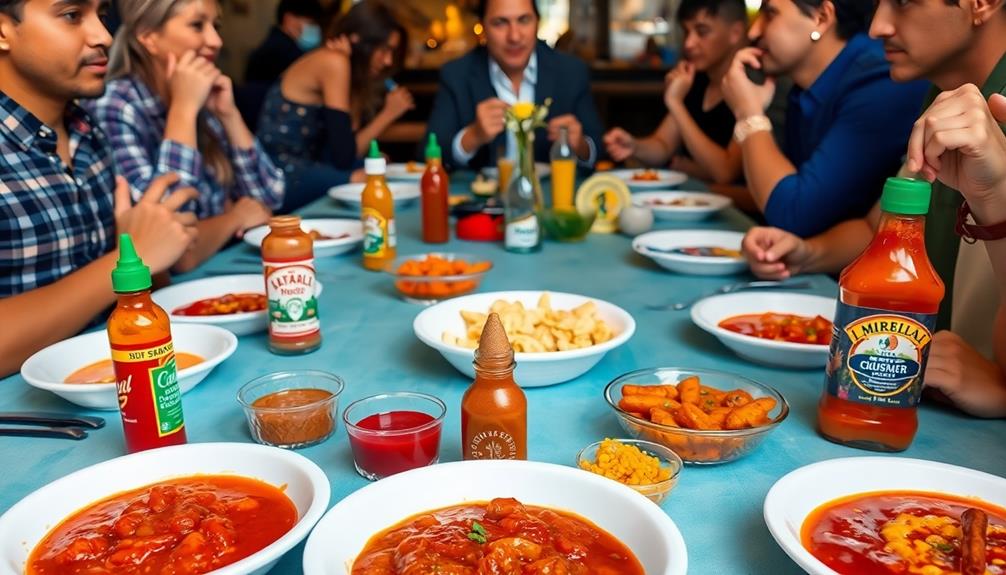
When you think about your favorite condiments, consider how your cultural background shapes those choices. Different regions have distinct flavor profiles that influence what you enjoy, from tangy soy sauce to spicy sriracha.
For instance, at Halloween gatherings, unique flavors can enhance themed foods, such as a graveyard taco dip that combines various cultural tastes.
Social factors, like family traditions and marketing messages, also play a big role in your condiment preferences, often tying them to your personality.
Cultural Flavor Associations
Cultural flavor associations play a significant role in shaping condiment choices, reflecting deeper social behaviors and personality traits. For instance, if you're drawn to spicy condiments, it might signal adventurousness and boldness, traits often celebrated in various cultural narratives. This is evident in the way dishes like Muamba De Galinha from Angola utilize vibrant flavors and spices, which may influence the preferences for accompanying condiments.
In many Asian cultures, flavors like umami are predominant, with condiments such as soy sauce and chili paste enhancing communal dining experiences. This reflects not just personal preference but also a collective identity rooted in culinary traditions.
You might notice that your emotional connections to specific condiments often stem from your cultural heritage, influencing your dietary habits over time. For instance, while ketchup is a beloved staple in American cuisine, it may seem overly sweet or even inappropriate in other regions. Such perceptions highlight how flavor associations vary across cultures, and they underscore the importance of social contexts in condiment selection.
Your preferences may shift based on the communal dining atmosphere or regional practices, revealing how interconnected food choices are with personal identity and societal influences. Ultimately, your condiment preferences are a flavorful tapestry woven from both personal and cultural threads. Additionally, studies have shown a surprising link between handwriting and flavor preference, suggesting that even the way we physically interact with food can be influenced by our personal identity and societal factors. This highlights the intricate and subconscious ways in which our food choices are tied to our individual and cultural experiences. Whether it’s the way we season our meals or the way we write our grocery lists, our preferences are a reflection of who we are and where we come from. These multi-faceted influences on our food choices demonstrate the complex and dynamic nature of our personal and cultural identities. The surprising connection between handwriting and food preferences suggests that our physical interactions with food are rooted in deeper societal and cultural factors, shaping both our individual tastes and how we engage with the culinary world. As we continue to explore the relationship between personal identity and food choices, it’s clear that our dining experiences are shaped not only by the flavors on our plates, but by the intricate web of influences that make up who we are.
Regional Preferences and Trends
Across different regions, preferences for condiments reveal a rich tapestry of culinary traditions shaped by local culture and ingredients. For instance, the American South leans heavily towards barbecue sauces, while Southeast Asia embraces bold flavors with spicy sauces like sriracha or sambal. In Mexico, the use of ingredients like fresh salsas reflects the vibrant and diverse flavor profiles that characterize its cuisine.
These condiment preferences reflect the regional culinary traditions and flavor profiles prevalent in each area.
Research shows that Mediterranean regions often favor olive oil and vinegar-based dressings, thanks to the local availability of these ingredients. The rise of international condiments, such as kimchi and harissa, highlights the growing interest in diverse cuisines among consumers in the United States, driven by cultural exchange.
Branding and marketing play an essential role in shaping these preferences, as companies tap into regional identities, fostering strong consumer loyalty.
Younger generations tend to experiment more with exotic and bold flavors, while older consumers often gravitate towards traditional options. Demographic factors greatly influence these trends, showcasing how your background and experiences can guide your condiment choices.
Ultimately, the diversity in condiment preferences illustrates the colorful interplay between culture, flavor, and personal taste across different regions.
Social Influences on Choices
Flavor preferences often reflect deeper social influences that shape our condiment choices. Cultural narratives often highlight how certain condiments resonate with specific personality traits; for instance, spicy sauces are linked to adventurousness. Your regional cuisine plays a significant role, too. If you grew up enjoying soy sauce in Asian dishes or salsa in Latin American meals, those flavors might define your palate.
For example, the popularity of Korean BBQ emphasizes the use of various dipping sauces that can reflect one's boldness and willingness to try new flavors.
Psychological factors also contribute. You may feel an emotional connection to a particular condiment, stemming from family traditions or shared cultural experiences. In social settings, peer influence can guide your choices. You might choose trendy condiments to fit in with friends or to adhere to social norms, which can dictate what's popular.
Moreover, marketing strategies exploit these cultural perceptions, promoting flavors that resonate with specific demographic groups. This often shapes consumer behavior, leading you to select certain condiments over others based on what's popular or culturally accepted.
Ultimately, your condiment preferences reflect a complex interplay of social influences, personality traits, and regional backgrounds, showcasing how deeply intertwined our choices are with the world around us.
Taste and Mood Dynamics
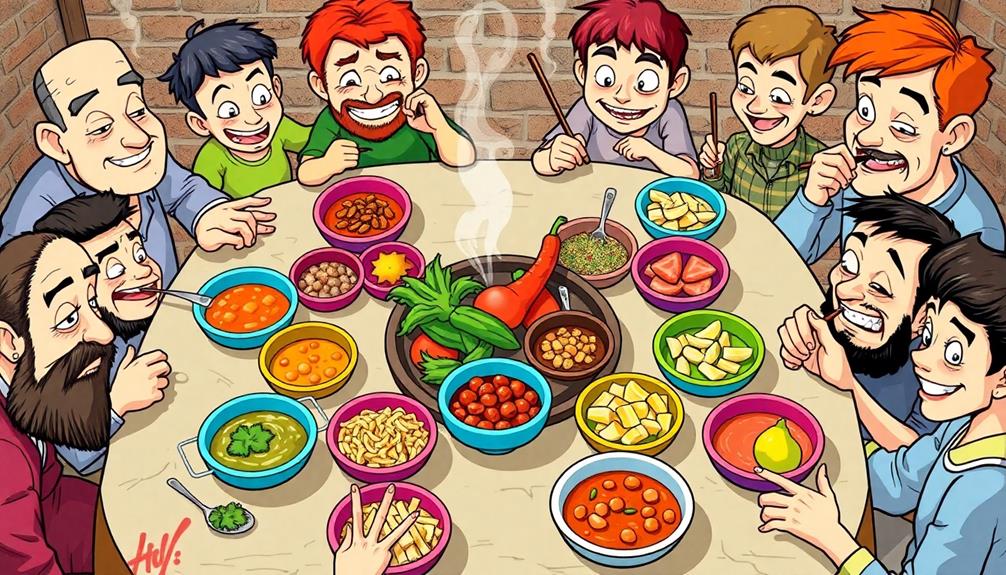
Taste is more than just a sensory experience; it's a powerful influencer of your emotions and social interactions. The flavors you prefer can notably impact your mood and emotional state. For instance, sweet tastes often enhance romantic feelings and encourage you to connect with others. Southern comfort foods, such as satisfying fried pork chops, can evoke feelings of nostalgia and warmth, making them particularly appealing during gatherings with loved ones.
Consider the following dynamics at play:
- Your mood can shape your taste preferences.
- Sweet flavors may boost your interest in forming social relationships.
- Anxious individuals often have a narrower range of taste preferences, affecting emotional well-being.
Research shows a bidirectional relationship between taste and mood, meaning your emotional state can alter how you experience flavor.
Neurotransmitters, influenced by your personality, also play an essential role in this dynamic. If you're feeling anxious, you might gravitate toward comfort foods, limiting your dietary choices.
On the other hand, savoring a favorite dish can uplift your spirits and expand your social horizons.
Research Insights on Personality Traits

Numerous studies reveal intriguing connections between personality traits and condiment preferences, highlighting how your character can shape your culinary choices. If you're someone who thrives on adventure, you might lean toward spicier condiments, as sensation-seeking individuals often do. Conversely, if you display lower neuroticism and higher agreeableness, sweet options like honey and ketchup may be your go-to, reflecting your prosocial tendencies.
The table below summarizes how different personality traits correlate with specific condiment preferences:
| Personality Trait | Preferred Condiment | Flavor Profile |
|---|---|---|
| Sensation-Seeking | Spicy sauces (e.g., hot sauce) | High flavor intensity |
| Low Neuroticism/High Agreeableness | Sweet condiments (e.g., ketchup) | Mild and sweet |
| Openness | Umami-rich condiments (e.g., soy sauce) | Complex flavors |
Anxious individuals may gravitate toward milder flavors, steering clear of novelty. Meanwhile, those with high extraversion often enjoy bold condiments, enhancing their social dining experiences. Understanding these links can help you appreciate how your personality influences your flavor choices!
Condiments and Psychological Factors

Your choices in condiments reveal more than just preference; they're influenced by psychological factors that shape your experiences and emotions. These factors often intertwine with your personality traits, reflecting deeper insights into who you are.
For instance, if you tend to lean toward spicy sauces, it might indicate a bold, adventurous spirit. Similarly, the flavors you gravitate towards, such as the unique taste of Hiyashi Chuka, may reflect your desire for rejuvenating experiences.
- Emotional connections play an essential role in your condiment preferences, often tied to specific memories or experiences.
- Cultural factors greatly influence your choices, as traditional flavors resonate with your background and upbringing.
- Effective branding and packaging can alter your flavor perception, making some condiments more appealing based solely on their visual presentation.
When making decisions about condiments, you may find that your choices align with certain personality traits. This connection often leads to strong brand loyalty, as you associate particular flavors with positive emotions.
As you explore your condiment preferences, consider how these psychological factors impact not just what you eat, but also how you relate to your food and the memories it evokes.
Ultimately, your condiment choices are a reflection of your unique psychological profile.
Implications for Dietary Choices
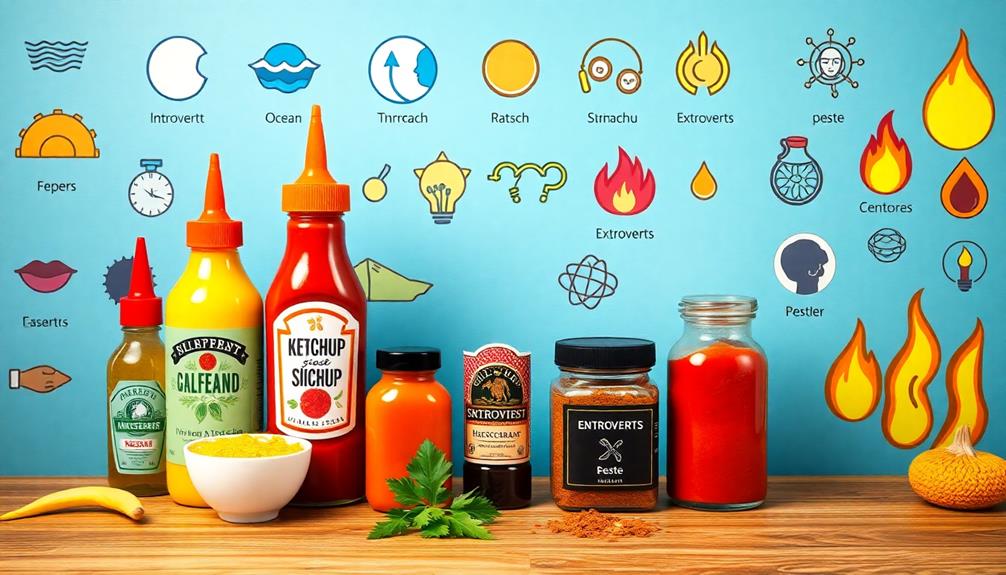
Condiment choices can considerably influence dietary habits, often reflecting deeper personality traits and preferences. If you're a sensation seeker, you might gravitate toward spicy sauces and unique flavor combinations, which can lead you to explore a more adventurous diet.
On the other hand, if you have sweet taste preferences linked to agreeable personality traits, you'll likely favor sweeter condiments like ketchup and honey mustard, potentially steering your dietary choices towards more comforting, familiar foods.
Individuals with higher neuroticism often show a limited range of condiment preferences, sticking to mild flavors that provide a sense of security. This can result in a more monotonous diet.
Curiously, age influences condiment preferences, with older adults typically developing a taste for complex flavors found in items like balsamic vinegar and hot sauces, reflecting a broader palate as they mature.
Cultural narratives also play a significant role in shaping your condiment preferences. Certain personality traits align with specific food practices, reinforcing how your background influences your dietary choices.
Understanding these connections can help you make more informed decisions about your eating habits and how they align with your personality.
Frequently Asked Questions
What Is the Relationship Between Personality Types and Reward Preferences?
Your personality type shapes your reward preferences, influencing what you find satisfying. If you're adventurous, you'll seek novel experiences. Conversely, if you're more cautious, you'll likely prefer familiar rewards that offer comfort and security.
What Is the Link Between Personality and Food Behavior?
Your personality influences your food choices greatly. If you're adventurous, you'll likely seek bold flavors, while more anxious individuals tend to stick to familiar, milder options, reflecting your comfort level with new experiences.
What Is the Psychology Behind Taste Preferences?
You're drawn to certain flavors based on your emotions and experiences. Your mood influences choices, while personality traits shape preferences, making you enjoy sweet comfort foods or bold, spicy dishes that match your adventurous spirit.
What Is the Connection Between Food and Behavior?
Food and behavior are closely intertwined; your choices reflect your mood and personality. When you crave certain flavors, it often reveals underlying emotions, showcasing how deeply your taste preferences influence your overall behavior and experiences.
Conclusion
So, next time you reach for that bottle of hot sauce or mustard, consider what your condiment choice says about you. Your personality traits might just be influencing your taste preferences in ways you never imagined. Isn't it fascinating how something as simple as a condiment can reflect deeper aspects of who we are? Embracing these connections can not only enhance your meals but also help you make more mindful dietary choices that align with your personality.
Cooking
The Surprising History of Color Additives in Food
Get ready to explore the unexpected journey of color additives in food, revealing how they transformed our culinary experiences and sparked new regulations.

Color additives have a fascinating history that transforms your perception of food. Ancient civilizations used natural pigments from saffron and berries, but the game changed in 1856 when synthetic dyes emerged. The 1906 Food and Drugs Act kicked off regulations, ensuring safety. You probably know that synthetic colors dominate processed foods, but there's a growing shift towards natural alternatives. Today's trends in aesthetics and health are reshaping how we view these additives. So, if you're curious about how these colors influenced food culture and regulation, you might find the next part of this story intriguing.
Key Takeaways
- Ancient civilizations used natural colorants like saffron and berries to enhance food appearance long before synthetic options were available.
- The discovery of the first synthetic dye, mauve, in 1856 by William Henry Perkin marked a significant shift in color additive usage.
- The 1906 Food and Drugs Act introduced regulatory oversight, ensuring safety and transparency in food color additives.
- The Delaney Clause of 1960 prohibited the use of cancer-causing color additives, tightening safety regulations around synthetic options.
- Consumer demand has prompted a modern shift towards natural colorants, despite synthetic colors still being prevalent in processed foods.
Definition and Types of Color Additives
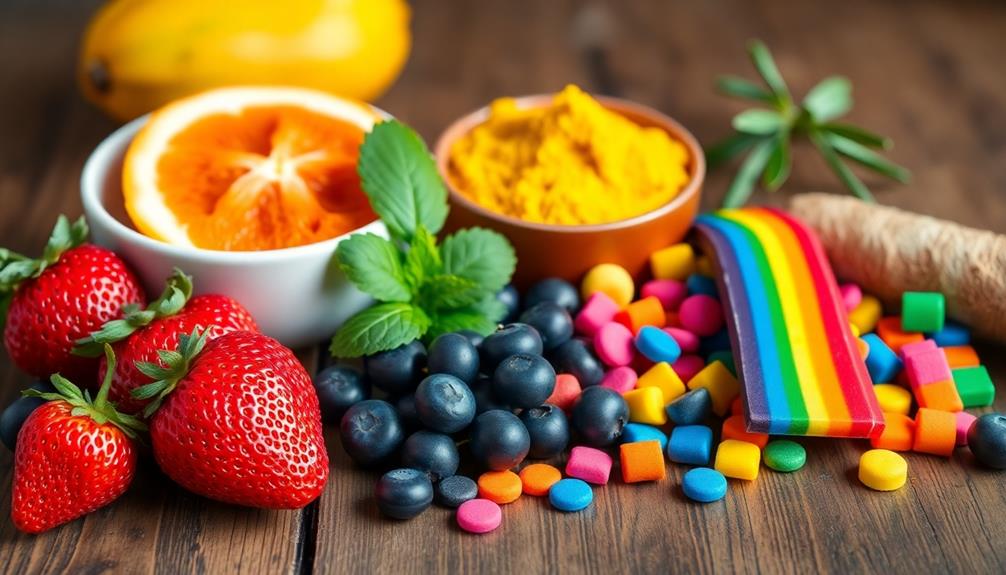
Color additives are essential substances that give vibrancy to our food, cosmetics, and even medicines. These additives come in various forms, primarily classified into dyes, lakes, and mixtures.
Dyes are water-soluble color additives frequently used in beverages and cosmetics, while lakes are insoluble pigments that are ideal for food products and certain cosmetic applications. For instance, many traditional dishes like Red-Braised Pork Belly utilize natural colorants to enhance their visual appeal and create an enticing presentation.
When it comes to sourcing these colorants, you'll find both natural and synthetic options. Natural colorants are derived from plants, minerals, and animals, offering a more organic touch. On the other hand, synthetic colorants are chemically manufactured, often providing greater stability and consistency in color.
It's important to note that the FDA has approved only seven synthetic colorings for use in food, and these certified color additives undergo rigorous safety evaluations before hitting the market.
Additionally, around 200 color additives are provisionally listed for interim use, reflecting ongoing regulatory efforts to guarantee public safety. By understanding the different types of color additives, you can make informed choices about the products you consume and use daily.
Historical Use of Color Additives
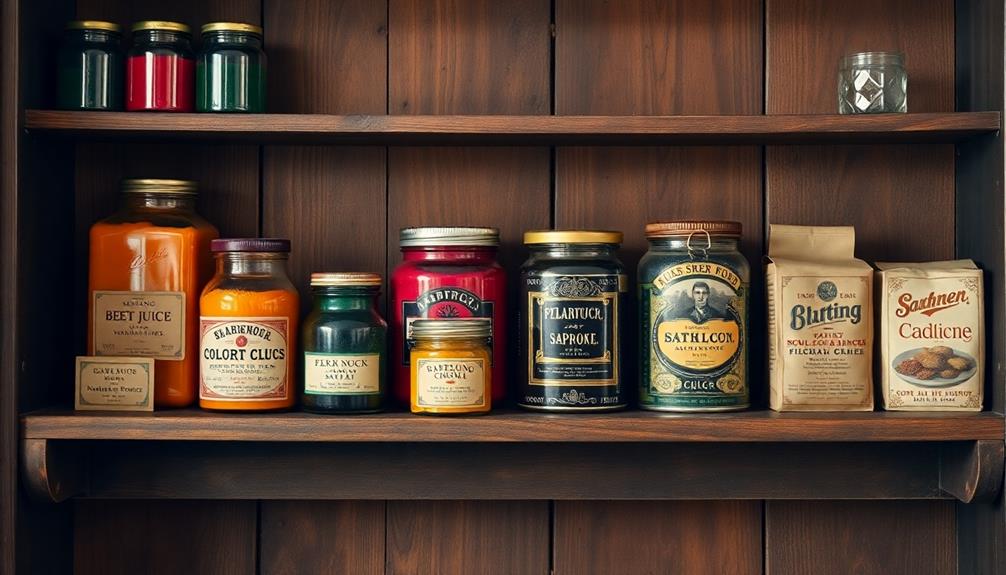
Throughout history, societies have sought ways to enhance the visual appeal of their food, leading to the use of color additives long before modern regulations came into play. Ancient civilizations utilized natural colors derived from sources like saffron, berries, and turmeric to make their dishes more attractive and flavorful.
| Time Period | Color Additive Types | Key Developments |
|---|---|---|
| Ancient Civilizations | Natural colors | Used for enhancing appearance |
| 1856 | Synthetic dyes | William Henry Perkin discovers mauve |
| Early 20th Century | Synthetic dyes | Widespread use in food products |
| 1906 | Regulatory scrutiny | 1906 Food and Drugs Act enacted |
| Modern Era | Shift to natural sources | Response to consumer expectations |
Regulatory Oversight and Developments

As the food industry evolves, regulatory oversight has stepped up to guarantee the safety of color additives. The Food and Drug Administration (FDA) plays an essential role in this process, requiring that any new color additives be proven safe for their intended use according to the Code of Federal Regulations (CFR).
The introduction of the Delaney Clause in 1960 greatly enhanced safety standards by prohibiting the approval of any color additives shown to cause cancer in humans or animals. This focus on safety is reminiscent of the care taken in traditional cooking methods in various cuisines, such as the regional variations seen in Brazilian dishes.
Currently, about 200 color additives are provisionally listed for interim use, with the FDA continuously monitoring them to ascertain they meet safety and regulatory requirements.
Before approval, each color additive undergoes rigorous testing, including toxicological studies and exposure assessments, to check for impurities and heavy metals.
In recent years, there's been an increased scrutiny on synthetic additives, reflecting a growing consumer preference for natural colorants. This shift has prompted ongoing regulatory updates to guarantee that public health safety is prioritized.
Health Implications of Color Additives

The safety of food color additives isn't just a regulatory concern; it has significant health implications for consumers. While artificial coloring can enhance the visual appeal of food, it's crucial to evaluate potential health concerns associated with these additives.
For instance, many traditional dishes, such as Mushroom Masala, rely on natural ingredients for their vibrant colors and flavors, showcasing that appealing food doesn't always require artificial enhancements.
Here are some key points to keep in mind:
- Regulatory Scrutiny: Historical incidents, like the 1950 Halloween candy scare, led to increased scrutiny and regulation of color additives to protect consumer safety.
- Natural Colorants: Although often seen as safer, natural colorants like cochineal extract can trigger allergic reactions in sensitive individuals.
- Hyperactivity Links: Ongoing studies suggest some synthetic color additives may be linked to hyperactivity and behavioral issues in children, raising concerns among parents and advocates.
- FDA Monitoring: The FDA has provisionally listed around 200 color additives, continually monitoring their safety to guarantee public health is prioritized.
Navigating the world of food additives requires transparency from manufacturers and awareness from consumers.
Trends in Food Colorings

Recent trends in food colorings reflect a significant shift towards natural alternatives, driven by consumers' increasing demand for healthier options and transparency in ingredient lists. As you explore the market, you'll notice that the use of synthetic dyes is declining, even though approximately 70% of processed foods in the U.S. still contain artificial colors. Consumers are actively seeking natural food colorings for their safety and aesthetic appeal.
| Trend Type | Description | Impact on Consumers |
|---|---|---|
| Natural Food Colorings | Shift from synthetic dyes to natural sources | Healthier choices |
| Edible Spray Paints | Innovations in food aesthetics | Enhances visual appeal |
| Regulatory Trends | Stricter oversight of synthetic additives | Increased consumer trust |
Additionally, vibrant colors in food enhance sensory experiences, influencing consumer preferences and product marketing. With regulatory trends emphasizing safety assessments, the future of food colorings leans toward transparency and health. By embracing these trends, you can enjoy a more colorful and safe culinary experience, one that aligns with modern consumer values.
Frequently Asked Questions
Why Is Red 40 Not Banned in the US?
Red 40 isn't banned in the U.S. because extensive safety testing has shown it's safe for consumption. Regulatory bodies prioritize scientific evidence, and no significant health risks have been established to warrant a ban.
When Did They Start Putting Additives in Food?
You'll find that food additives began appearing in the mid-19th century. They enhanced flavors, improved appearances, and preserved freshness. Over time, regulations evolved to guarantee safety, shaping the standards you see today in food products.
When Did Dyes Start Being Added to Food?
Dyes started being added to food in the 19th century, with the discovery of synthetic dyes. By the early 20th century, these artificial colorants became common in food processing, enhancing appearance and standardization.
Why Was Red Dye 2 Banned in the 1970S?
When it comes to safety, you can't be too careful. Red Dye No. 2 got banned in the 1970s due to concerns over cancer risks highlighted by studies linking it to potential carcinogenic effects in animals.
Conclusion
As you explore the vibrant world of food color additives, you'll uncover a rich tapestry of history entwined with safety concerns. While these hues can enhance your culinary experience, they also raise questions about health implications and regulatory measures. Striking a balance between visual appeal and well-being is essential; the bright colors that entice your senses may carry hidden risks. Ultimately, understanding this duality empowers you to make informed choices about what you consume.
Cooking
How Different Cooking Oils Affect Cholesterol Levels
Cooking oils can significantly impact your cholesterol levels, but which ones will truly benefit your heart health? Discover the best choices for a healthier lifestyle.
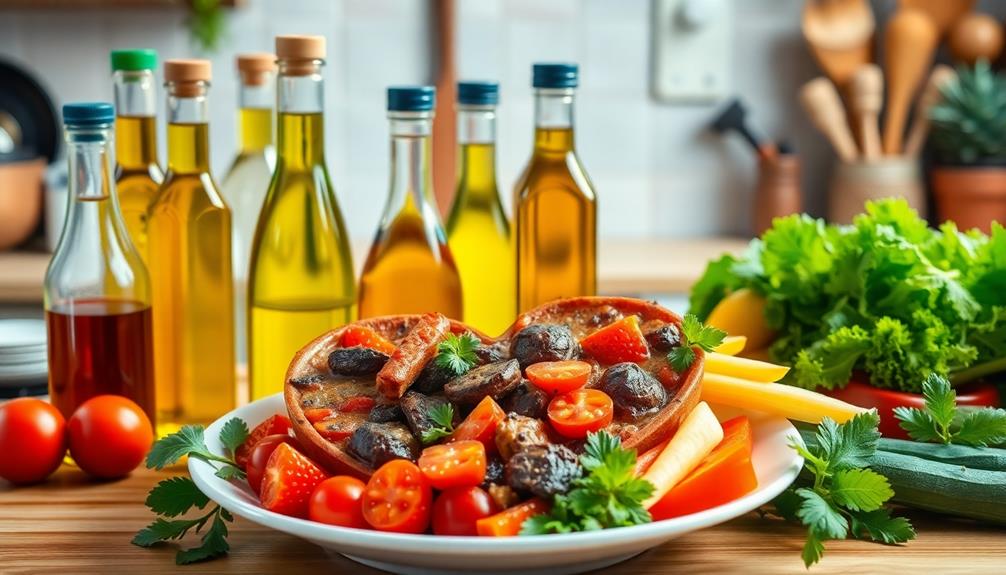
Different cooking oils can greatly affect your cholesterol levels. Oils high in monounsaturated fats, like olive and canola oil, can lower LDL cholesterol while raising HDL cholesterol. In contrast, saturated fats found in butter and palm oil can increase LDL levels, raising your heart disease risk. Polyunsaturated fats, especially omega-3s from flaxseed and fish oil, also benefit your heart health. By choosing healthier oils and cooking methods, you can improve your cholesterol profile. To make better choices for your cooking, you might be interested in exploring more details about the oils that fit your lifestyle.
Key Takeaways
- Unsaturated fats, such as those found in olive and canola oils, lower LDL cholesterol levels, promoting heart health.
- Saturated fats, prevalent in animal products and tropical oils, can raise LDL cholesterol and should be limited.
- Omega-3 rich oils, like flaxseed and fish oil, improve overall heart health by lowering triglycerides and reducing inflammation.
- High smoke point oils, such as avocado and canola, are better for cooking at high temperatures without forming harmful compounds.
- Cooking methods influence cholesterol levels; healthier methods like steaming should replace high-saturated fat frying techniques.
Understanding Dietary Fats

When you think about dietary fats, it's essential to understand their different types and how they affect your cholesterol levels. Dietary fats fall into two main categories: saturated fats and unsaturated fats.
Saturated fats, typically solid at room temperature, can raise LDL cholesterol levels and are mainly found in animal products and tropical oils like coconut and palm oil. Notably, some traditional dishes, like Red-Braised Pork Belly, utilize cuts of meat that are higher in saturated fat, emphasizing the importance of moderation in enjoying such rich flavors.
On the other hand, unsaturated fats are liquid at room temperature and include both monounsaturated and polyunsaturated fats, which can help lower cholesterol levels.
Monounsaturated fats, found in oils such as olive and canola, improve your LDL and HDL cholesterol ratios, promoting overall heart health. Polyunsaturated fats, particularly omega-3 fatty acids present in fatty fish, can also enhance your cholesterol profile and reduce inflammation, lowering the risk of cardiovascular disease.
The American Heart Association recommends limiting saturated fat intake to no more than 6% of your total daily calories to maintain healthy cholesterol levels.
Types of Cooking Oils

When choosing cooking oils, it's essential to understand the differences between healthy and unhealthy fats.
For instance, oils that are rich in unsaturated fats, like olive oil, can be beneficial for heart health, while saturated fats can contribute to higher cholesterol levels.
You'll want to take into account the smoke points of various oils, as they affect how well they perform in different cooking methods.
Healthy Oil Choices
Choosing the right cooking oils can make a significant difference in your overall health, especially concerning cholesterol levels. For heart health, focus on oils rich in monounsaturated fats, like olive and avocado oil. These oils can lower LDL cholesterol while raising HDL cholesterol, making them excellent choices for your kitchen.
Additionally, incorporating oils that reflect diverse culinary traditions, such as those used in Brazilian Cuisine, can introduce beneficial fats to your diet.
Polyunsaturated fats found in soybean and corn oils are also beneficial. They help reduce overall cholesterol levels when you replace saturated fats, which are commonly found in tropical oils like coconut and palm oil. Since saturated fats can raise LDL cholesterol, it's wise to limit their intake for better heart health.
Incorporating oils high in omega-3 fatty acids, such as flaxseed and canola oil, can further improve your cholesterol profile. These oils not only lower triglyceride levels but also contribute positively to your overall heart health.
Smoke Points Explained
Understanding smoke points is essential for cooking with oils effectively and healthily. The smoke point is the temperature at which an oil begins to smoke, signaling potential breakdown and the release of harmful free radicals. Using oils with low smoke points for high-heat cooking can lead to the formation of trans fats, negatively impacting cholesterol levels.
Here's a quick reference table to help you understand different oils and their smoke points:
| Oil Type | Smoke Point (°C/°F) | Cooking Uses |
|---|---|---|
| Extra-Virgin Olive Oil | 150°C / 302°F | Dressings, low-heat cooking |
| Canola Oil | 225°C / 437°F | Frying, high-heat cooking |
| Safflower Oil | 225°C / 437°F | Frying, sautéing |
| Avocado Oil | 271°C / 520°F | Versatile high-heat cooking |
| Coconut Oil | 177°C / 350°F | Medium-heat cooking |
High smoke point oils, like canola and avocado, are ideal for frying while preserving their healthy benefits. In contrast, reserve extra-virgin olive oil for low-heat applications to maintain its integrity and health properties.
Avoiding Unhealthy Fats
Selecting the right cooking oil is key to maintaining healthy cholesterol levels. To support your heart health, it's crucial to avoid unhealthy fats, particularly saturated and trans fats. Saturated fats, found in oils like coconut and palm oil, can raise LDL cholesterol levels, so use them sparingly.
On the other hand, trans fats, often present in partially hydrogenated oils, greatly increase your risk of coronary artery disease by raising LDL cholesterol and lowering HDL cholesterol. Incorporating heart-healthy ingredients like nutritious dishes can further enhance your diet.
Instead, choose cooking oils rich in unsaturated fats, such as olive, canola, and avocado oil. These oils can help improve cholesterol levels by lowering LDL cholesterol.
Regularly incorporating oils high in polyunsaturated fats, like soybean and corn oil, can also promote overall heart health and reduce LDL cholesterol levels.
Always read food labels to steer clear of oils high in saturated fat or trans fats. By making these conscious choices, you can maintain a healthy cholesterol balance and greatly lower your risk of heart disease. Your heart will thank you for it!
Impact on Cholesterol Levels
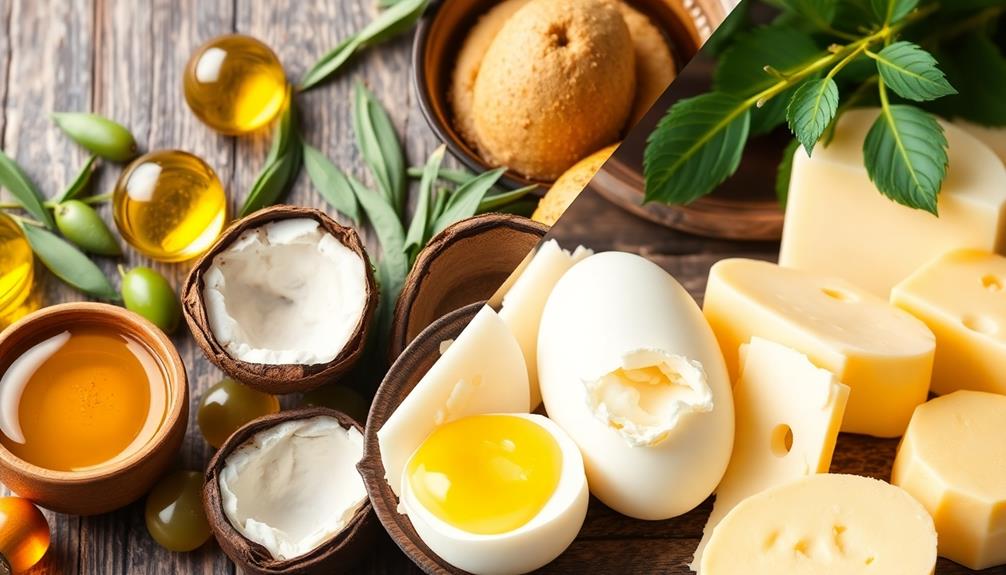
When you choose your cooking oils, it's essential to understand the difference between healthy and unhealthy fats.
For instance, oils rich in omega-3s, like flaxseed oil, can be beneficial for heart health, while others might contribute to higher cholesterol levels.
The way you cook can also affect how these fats impact your cholesterol levels.
Healthy vs. Unhealthy Fats
In the domain of cooking oils, the types of fats you choose can greatly impact your cholesterol levels and overall heart health. Saturated fats, commonly found in fatty meats and full-fat dairy, can elevate LDL cholesterol levels, increasing your risk of coronary artery disease.
To promote better heart health, consider replacing these with monounsaturated fats, like those in olive and canola oils, which help lower LDL cholesterol while raising HDL cholesterol. For example, incorporating healthy snacks like Kue Putu (Bamboo Rice Cake) can provide a delicious way to enjoy healthier fats.
Polyunsaturated fats, found in corn and soybean oils, also support healthy cholesterol levels and can improve your lipid profile when included in your dietary fat.
However, beware of trans fats, often lurking in partially hydrogenated oils and processed foods. These unhealthy fats greatly raise LDL cholesterol and lower HDL cholesterol, posing a high risk for heart disease.
The American Heart Association recommends limiting your saturated fat intake to no more than 6% of your total daily calories to maintain healthy cholesterol levels.
Impact of Cooking Methods
The way you cook can profoundly influence your cholesterol levels and overall heart health. Cooking methods that involve high amounts of saturated fats, like frying with lard or butter, can greatly raise your LDL cholesterol levels, increasing your risk of heart disease. On the other hand, healthier options like olive or canola oil can help lower LDL cholesterol and promote better heart health.
Steaming or boiling foods, which don't add extra fats, can also help maintain healthier cholesterol levels compared to frying. In addition, incorporating oils rich in omega-3 fatty acids, such as flaxseed or walnut oil, can provide extra heart-healthy benefits.
Here's a quick comparison of cooking methods:
| Cooking Method | Impact on Cholesterol Levels |
|---|---|
| Frying with Lard | Increases LDL cholesterol |
| Frying with Butter | Increases LDL cholesterol |
| Using Olive Oil | Lowers LDL cholesterol |
| Steaming | Maintains healthier cholesterol |
| Using Omega-3 Oils | Supports better cholesterol profiles |
Healthier Oil Choices
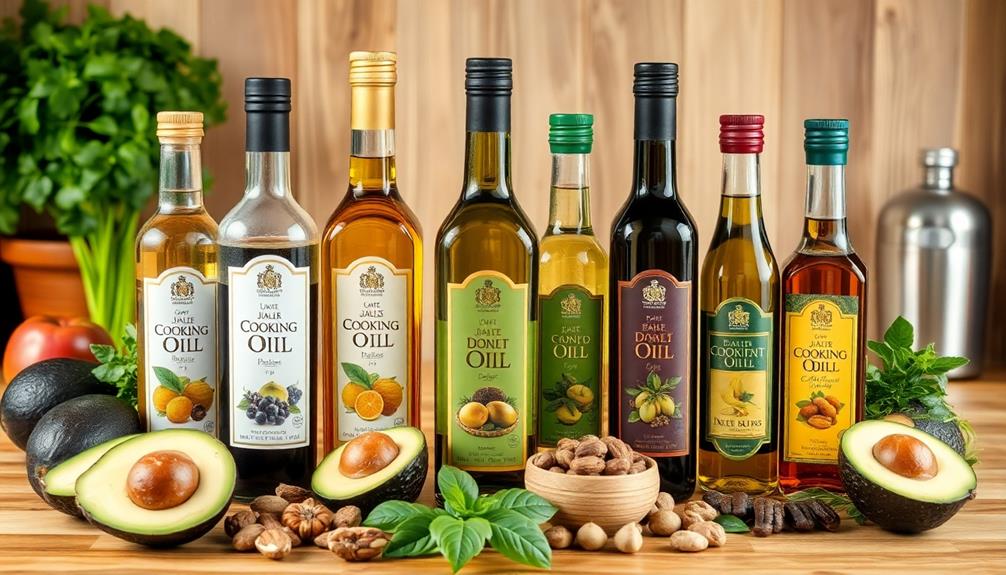
Making healthier oil choices can have a considerable impact on your cholesterol levels and overall heart health. By opting for oils rich in monounsaturated fats, like olive and canola oil, you can lower LDL cholesterol while boosting HDL cholesterol, which promotes heart health.
Exploring culinary traditions from around the world can provide a variety of delicious recipes that utilize these healthier oils. Incorporating polyunsaturated fats from oils such as soybean and corn oil can also help reduce overall cholesterol levels when you replace them for saturated fats.
Don't forget to include omega-3 rich oils, like flaxseed and fish oil, in your diet. These oils can improve your lipid profiles and support cardiovascular health.
When selecting vegetable oils, choose those with low saturated fat content, like safflower and grapeseed oil. This choice can help minimize your risk of heart disease by maintaining healthier cholesterol levels.
Replacing butter and other solid fats with heart-healthy oils is a simple way to considerably lower your saturated fat intake, which is linked to elevated cholesterol and an increased risk of coronary artery disease.
Cooking Methods and Oils

When it comes to cooking methods, choosing the right oils can greatly affect your cholesterol levels and overall health. By swapping out saturated fats, like butter, for cooking oils rich in monounsaturated fats, such as olive and canola oil, you can lower your LDL cholesterol levels and support heart health.
For instance, many Indian dishes, such as Mushroom Masala, can be made healthier by using these oils, enhancing both flavor and nutrition.
If you're frying or cooking at high temperatures, opt for oils with high smoke points, like avocado or canola oil. These oils remain stable under heat, preventing the formation of harmful compounds that could negatively impact your cholesterol levels.
Incorporating oils packed with polyunsaturated fats, such as corn and soybean oil, into your diet can further promote heart health by lowering overall cholesterol levels.
Additionally, consider your cooking methods. Sautéing or baking with healthy oils is a great alternative to deep frying, which often leads to unhealthy trans fats.
These trans fats can elevate your cholesterol levels and increase the risk of heart disease. By choosing vegetable oils over tropical oils high in saturated fats, you can considerably improve your cholesterol profile and support your overall cardiovascular health.
Reducing Unhealthy Fats
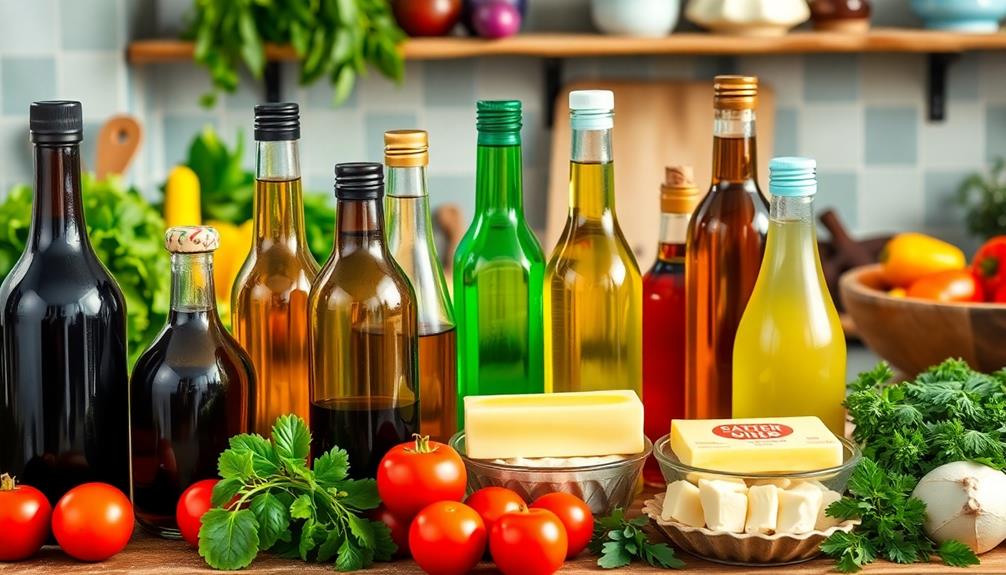
Reducing unhealthy fats is an essential step in improving your cholesterol levels and overall heart health. One effective way to achieve this is by substituting olive oil for butter in your cooking. This simple swap can greatly lower your saturated fat intake, which helps reduce LDL cholesterol levels.
In addition, incorporating fatty fish rich in omega-3s, like salmon, into your meals at least twice a week can boost your overall health and support heart health. For a flavorful twist, consider using olive oil in traditional dishes like Agnolotti to enhance both taste and health benefits.
When it comes to meats, opt for lean cuts and skinless poultry instead of fatty options. This change minimizes your saturated fat consumption and lowers your cholesterol levels. Moreover, limiting processed foods that are often high in saturated fats is essential for better cholesterol management.
Making smart snack choices is equally important. Choose whole fruits and vegetables instead of fried or high-fat options to additionally decrease your overall unhealthy fat intake.
Benefits of Healthy Fats
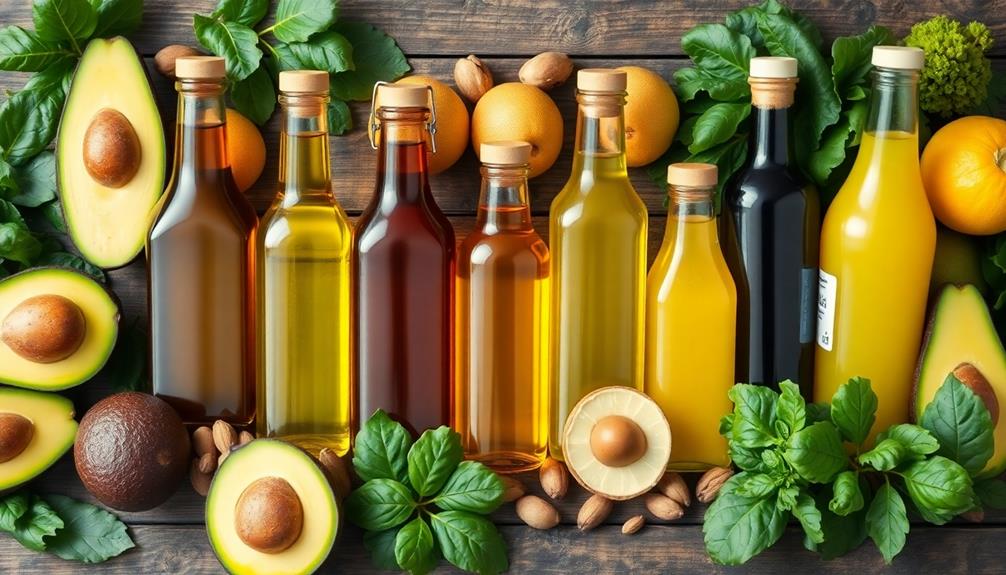
Healthy fats play an essential role in your diet, offering numerous benefits for heart health. By incorporating healthy fats, particularly monounsaturated fats found in olive oil and avocados, you can lower LDL cholesterol levels while raising HDL cholesterol. This balance is fundamental for promoting heart health.
Additionally, traditional Ethiopian dishes like Yekolo (Roasted Barley) highlight the importance of including nutrient-dense foods that can support overall wellness.
Polyunsaturated fats, especially omega-3 fatty acids from fatty fish like salmon, are important for reducing inflammation and enhancing overall cardiovascular health. Including nuts and seeds in your meals, which are rich in healthy fats, can also lead to decreased total cholesterol levels and a lower risk of heart disease.
Replacing saturated fats with unsaturated fats in your cooking is another effective strategy. Experts recommend that no more than 6% of your daily calories come from saturated fats, as excessive intake can increase the risk of coronary artery disease.
Using cooking oils like canola and safflower, which are high in unsaturated fats, can greatly contribute to healthier lipid profiles. When you make these simple swaps and focus on healthy fats, you're taking essential steps toward better heart health and improved cholesterol levels.
Practical Cooking Tips
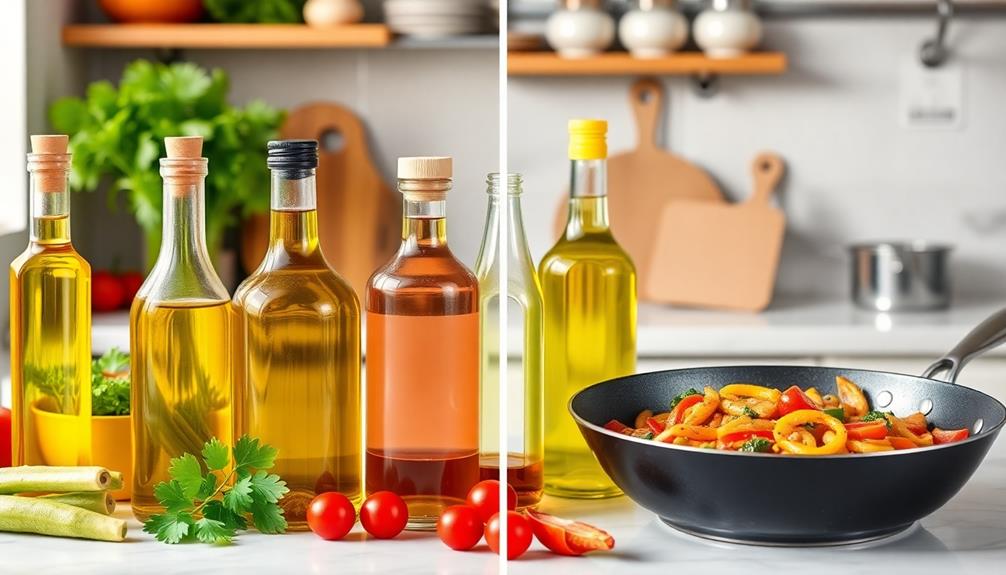
Incorporating practical cooking tips can greatly enhance your heart health while managing cholesterol levels. Start by using olive oil instead of butter in your recipes; it's rich in monounsaturated fats, which help lower LDL cholesterol. For baking and frying, opt for canola oil due to its high smoke point and heart-healthy profile, with about 62% monounsaturated fats.
Make sure to include fatty fish like salmon in your meals at least twice a week to provide essential omega-3 fatty acids, which can improve cholesterol levels. Limit your use of tropical oils, such as coconut and palm oil, as they are high in saturated fats that can raise cholesterol levels.
When cooking at high temperatures, choose oils with high smoke points like safflower or peanut oil to prevent harmful free radicals from forming. Here's a quick reference table for your cooking oil options:
| Oil Type | Fat Composition | Best Use |
|---|---|---|
| Olive Oil | High in Monounsaturated | Sautéing, Dressings |
| Canola Oil | 62% Monounsaturated | Baking, Frying |
| Safflower Oil | High Smoke Point | High-Heat Cooking |
| Coconut Oil | High Saturated Fats | Limit Usage |
| Fatty Fish | Omega-3 Fatty Acids | Meals Twice a Week |
Frequently Asked Questions
What Cooking Oils Are Bad for Cholesterol?
When considering cooking oils, you'll want to avoid those high in saturated and trans fats. Oils like coconut, palm, and hydrogenated oils can negatively impact your cholesterol levels, increasing the risk of heart disease.
What Oil Is Better for Your Cholesterol?
To improve your cholesterol, choose oils high in monounsaturated and polyunsaturated fats, like olive and canola oil. These oils can help lower bad cholesterol while boosting good cholesterol, promoting better heart health overall.
What Is the Healthiest Oil to Cook With?
Studies show that olive oil can reduce heart disease risk by 30%. When choosing the healthiest oil to cook with, go for olive or avocado oil for their beneficial fats, versatility, and overall heart health support.
Is Frying in Olive Oil Bad for Cholesterol?
Frying in olive oil isn't bad for cholesterol; in fact, it can be beneficial. Its monounsaturated fats help lower LDL cholesterol and raise HDL cholesterol, promoting a healthier heart when used in moderation.
Conclusion
In the grand symphony of your diet, the choice of cooking oils plays a vital note. By opting for healthier oils, you can harmonize your cholesterol levels and support heart health. Remember, not all fats are foes; some can be your allies. So, as you stir, sauté, or drizzle, keep these insights in mind. With a thoughtful approach to your cooking oils, you can savor delicious meals while nurturing your well-being. Your heart will thank you!
Cooking
The Psychological Effects of Solo Dining in Different Societies
The psychological effects of solo dining vary widely across cultures, revealing hidden insights into societal values and personal well-being that you won’t want to miss.

Solo dining has different psychological effects in various societies. In Western cultures, it's increasingly accepted, promoting independence and personal growth. However, in places like Japan and South Korea, solo dining often carries stigma and can lead to feelings of loneliness and depression. Younger generations in China and South Korea are more open to eating alone, while older individuals may struggle with the emotional impact. Despite these challenges, solo eating can enhance self-awareness and provides a unique opportunity for mindfulness. Understanding these diverse experiences can reveal much more about the complexities of solo dining across cultures.
Key Takeaways
- Solo dining can lead to increased feelings of loneliness and depression, especially in cultures with strong communal meal traditions, like South Korea and Japan.
- In Western societies, solo dining is becoming more accepted, promoting individualism and reducing stigma, which may positively affect mental well-being.
- Younger generations in China and South Korea are more likely to embrace solo dining, linking it to personal autonomy and convenience, despite existing social stigma.
- Effective dining environments that cater to solo diners can enhance comfort and promote positive dining experiences, contributing to improved mental health.
- Education on the benefits of solitude can shift perceptions of solo dining from negative to fulfilling, fostering personal growth and self-awareness.
Cultural Perspectives on Solo Dining

Solo dining is becoming a fascinating social phenomenon across various cultures. In South Korea, for instance, you'll notice an increasing acceptance of dining alone, reflecting a shift in social norms and attitudes toward independence. This trend shows how societal values can evolve, allowing solo dining experiences to flourish.
Additionally, unique culinary options, such as Mushroom Masala, can enhance the solo dining experience, allowing individuals to savor rich flavors at their own pace.
Meanwhile, in China, the rise of solo dining is notable, especially with 240 million single adults reported in 2020. Younger generations are embracing this lifestyle, even as traditional views on communal eating persist.
However, cultural stigma surrounding solo dining varies globally. In countries like Japan, dining alone often carries a negative connotation, while in Western societies, such as the U.S. and the UK, it's becoming more normalized.
Urban areas still present challenges, as solo diners frequently encounter stigma or negative perceptions. Yet, innovative marketing strategies that promote positive dining experiences can foster a more welcoming atmosphere.
Ultimately, generational differences play a significant role in shaping attitudes toward solo dining. Younger people are generally more open to enjoying meals alone, signaling a broader cultural shift that embraces individualism over communal dining traditions.
Emotional Impact of Eating Alone

Eating alone can have profound emotional effects on individuals, often leading to feelings of loneliness and depression. Studies reveal that frequent solo dining correlates with higher rates of depression and suicidal thoughts. For instance, in South Korea, female students who often eat alone report increased depression levels.
In Brazil, communal dining is an integral part of the culture, where sharing traditional dishes like Caldeirada can foster social connections and enhance emotional well-being.
Here are some key negative aspects of eating alone:
- Higher odds of experiencing depression (odds ratio of 1.42).
- Notable depressive symptoms reported by 22.9% of individuals who dine solo.
- Emotional distress increases, especially among older adults and lower-income individuals.
- Lack of emotional congruence with others can worsen mood.
When you find yourself dining alone, it's important to recognize how it might affect your mental health. Shared meals are linked to improved well-being, while solitary dining may contribute to negative perceptions.
As the need for social eating interventions grows, consider seeking out communal dining experiences to enhance your emotional state. Engaging with others can mitigate the negative aspects of eating alone and promote a healthier mindset.
Societal Stigma and Acceptance

Dining alone often comes with a heavy social stigma, especially in cultures that emphasize communal meals. In places like South Korea, these cultural norms dictate that eating together is a key part of social interaction, leading to negative perceptions of solo dining. This is particularly evident in the context of traditional dishes such as bulgogi, where sharing meals enhances the experience and connection between diners.
A significant percentage of Korean adults report dining alone, which is often linked to feelings of depression and even suicidal thoughts. This reflects a broader societal stigma that can make you feel isolated when you choose to eat by yourself.
In contrast, China is witnessing a shift in attitudes toward solo dining, particularly among younger generations. With a staggering 240 million single adults in 2020, acceptance is growing, suggesting that cultural norms are evolving. Yet, the preference for eating together still dominates in countries like Japan and Korea, where solo dining remains less accepted.
While Western societies are embracing solo dining—evidenced by an 80% increase in New York from 2014 to 2018—Asian cultures still grapple with the stigma surrounding it. This stark difference highlights how societal acceptance varies greatly across regions, influencing your experience when dining alone.
Solo Dining in Western Cultures

In Western cultures, solo dining is becoming more accepted, with many people embracing the trend despite lingering stigma.
This shift mirrors the growing popularity of comfort foods, such as a Loaded Baked Potato, which can be enjoyed alone or shared.
You might notice how this shift reflects changing social norms and impacts mental health, as more individuals choose to enjoy meals alone.
As you explore this topic, consider how these dining habits relate to overall well-being and societal perceptions.
Mental Health Implications
Many people in Western cultures find that solo dining can lead to increased feelings of loneliness and depression. Research shows that eating alone greatly contributes to mental health issues, including anxiety and depressive symptoms.
This psychological impact is often exacerbated by stigma and negative perceptions surrounding solo dining, making you feel even more isolated. Not only does solo dining lack the communal experience that can enhance meal enjoyment, but it can also deprive individuals of the rich flavors and textures found in dishes like Nettle and Potato Soup that are often best shared with others.
Here are some key points to reflect on:
- Increased Loneliness: Solo diners frequently report feeling lonely during meals.
- Higher Depression Rates: Studies indicate that individuals who dine alone have higher rates of depression.
- Stigmatization: There's a societal stigma attached to eating alone, which can worsen mental well-being.
- Demographic Vulnerability: Older adults and those from lower socioeconomic backgrounds face greater risks of mental health issues related to solo dining.
In urban settings, as solo dining becomes more common, you may still experience emotional consequences. The shift towards accepting eating alone doesn't erase the emotional toll it can take.
Understanding these mental health implications is important for recognizing how solo dining affects your psychological state and overall well-being.
Changing Social Norms
A notable shift in social norms has emerged around solo dining in Western cultures, transforming how people perceive eating alone. Once viewed as a sign of social isolation, solo dining is now increasingly accepted and even embraced. You might be surprised to learn that one-third of Britons eat alone regularly, and cities like New York saw an 80% increase in solo dining from 2014 to 2018.
This change reflects a broader trend towards individualism and personal autonomy, similar to how comfort foods like Red-Braised Pork Belly are enjoyed solo during family gatherings.
As these changing social norms take root, solo dining is recognized as a personal choice rather than a stigma. In fact, 30% of European restaurant guests identify as solo diners, highlighting a growing independence in dining habits.
However, it's crucial to reflect on the implications on mental health. While communal meals are linked to improved well-being, solo dining can sometimes lead to feelings of loneliness and depression.
The evolving restaurant market is responding to these trends, catering specifically to solo diners and making their experience more enjoyable. In this new landscape, you can savor your meal without the weight of societal judgment, embracing your choice to dine alone in a more accepting world.
Dining Alone Trends
Solo dining trends have gained significant traction in Western cultures, reshaping how we view eating alone. You might notice that dining solo isn't just accepted; it's becoming a norm. In fact, around one-third of Britons regularly eat alone, with urban areas like New York seeing an 80% increase in solo dining from 2014 to 2018. This shift indicates a growing acceptance of solo dining that reflects deeper cultural changes.
Enjoying a meal, whether it's a comforting squash casserole or a classic dish, can enhance the solo dining experience by offering a taste of home.
Here are some key points about this trend:
- Many European restaurant guests (30%) identify as solo diners.
- Independence and convenience are major motivations for solo dining.
- The trend addresses mental health issues, such as loneliness and depression.
- Restaurants are adapting to create welcoming environments for solo diners.
As you embrace dining alone, you might find it empowering rather than isolating. The increased acceptance of solo dining can help alleviate some mental health issues, promoting a sense of belonging in a world that often emphasizes togetherness.
With restaurants recognizing your needs, solo dining can be an enjoyable experience that fosters personal reflection and culinary exploration.
Solo Dining in Eastern Cultures

In Eastern cultures, the landscape of dining alone is rapidly evolving, reflecting broader societal changes. You'll notice that solo dining is gaining acceptance, particularly among younger generations. For instance, South Korea has seen a significant rise in individuals opting for solitary meals, with 22.9% of adults reporting they dine alone. However, this trend also highlights mental health concerns, as studies indicate a correlation with increased rates of depression and suicidal ideation.
Japan has adapted by creating "low interaction dining" experiences, specifically designed for solo diners seeking privacy. In China, 46% of individuals now embrace solo dining, showcasing a shift in cultural norms.
Here's a quick overview of solo dining trends in Eastern cultures:
| Country | Solo Dining Acceptance |
|---|---|
| South Korea | Increasing, 22.9% dine alone |
| Japan | Low interaction dining growth |
| China | 46% embrace dining alone |
| Emotional Well-Being | Positive interactions enhance satisfaction |
| Mental Health Concerns | Linked to higher depression rates |
As you navigate these dining practices, consider how emotional well-being can be influenced by your solo dining experiences in these cultures.
Psychological Benefits of Solitude

How often do you take time for yourself in a world that constantly demands your attention? Engaging in solo dining can be a powerful way to embrace solitude and reap its psychological benefits.
When you choose to dine alone, you create a space for emotional regulation and self-reflection, enhancing your mental well-being. Research shows that self-determined solitude can lower depression levels and foster creativity. Enjoying a meal like Yekolo (roasted barley) can further enhance this experience, as its nutty flavor and texture encourage mindfulness.
Consider these benefits of solo dining:
- Enhanced Emotional Regulation: Taking time to yourself helps you process emotions and reduces stress.
- Increased Mindfulness: Focusing on your meal allows you to appreciate flavors, textures, and the overall dining experience.
- Strengthened Creativity: Solitary experiences often lead to improved problem-solving skills and innovative thinking.
- Personal Autonomy: You can choose what, when, and how to eat without external pressures, promoting a sense of freedom.
Despite societal stigma, many individuals who engage in solo dining report feelings of comfort and contentment.
Embracing solitude can be a transformative experience, nurturing both your mind and spirit while allowing you to savor the moment.
Strategies to Enhance Solo Dining Experience

To make your solo dining experience more enjoyable, focus on the environment around you.
Look for restaurants that create inviting spaces and encourage social interactions, which can help you feel more at ease.
For instance, enjoying a dish like Dorayaki (Red Bean Pancake) can enhance your experience, as it's often enjoyed as a comforting snack or dessert.
Adopting a positive mindset can also transform your meal into a rewarding moment of self-discovery and satisfaction.
Designing Inviting Spaces
Creating inviting spaces for solo dining can transform the experience from isolating to enjoyable. By thoughtfully designing the dining environment, you can break down psychological boundaries and enhance your solo dining experience. Incorporating elements such as traditional stuffed pasta can provide a comforting culinary touch that enhances the overall atmosphere.
Focus on the following strategies to foster comfort and satisfaction:
- Effective spatial arrangements: Maintain personal space and adequate table distance to provide comfort and privacy.
- Inviting decor and ambient lighting: Use warm colors and soft lighting to create a welcoming atmosphere that encourages relaxation.
- Designated solo dining areas: Implement spaces specifically for solo diners, allowing them to feel a sense of belonging.
- Tailored seating arrangements: Offer seating options that cater to individual preferences, such as cozy nooks or communal tables.
These elements not only improve your overall experience but also increase customer loyalty.
Encouraging Social Interactions
Solo dining doesn't have to be a lonely experience; in fact, there are several strategies you can use to foster social interactions that enhance your meal. Start by choosing restaurants that prioritize personal space and effective spatial arrangements, making you feel more comfortable and open to engaging with others. You might also look for community dining events or themed solo dining nights, where you can share a meal with fellow diners, reducing feelings of isolation.
Consider utilizing technology, like apps designed to connect solo diners. These platforms can help you find others who are looking to share a meal, creating opportunities for social interactions.
Lastly, be open to interactions with restaurant staff. Trained personnel who engage positively with you can provide emotional support and make your dining experience more enjoyable.
Here's a quick overview of these strategies:
| Strategy | Description | Benefit |
|---|---|---|
| Community Dining Events | Join themed nights for solo diners | Reduces isolation |
| Technology Connections | Use apps to find dining companions | Fosters social interactions |
| Staff Engagement | Encourage staff to interact with solo diners | Enhances emotional well-being |
Promoting Positive Mindset
Embracing the solo dining experience can greatly enhance your mindset and overall enjoyment of meals alone. By promoting positive attitudes towards dining solo, you can reduce the stigma associated with eating alone and discover the benefits of self-determined solitude.
Here are some strategies to enhance your solo dining experience:
- Choose welcoming restaurants that prioritize privacy and comfort.
- Look for community events that connect solo diners, fostering a sense of belonging.
- Take advantage of solo diner-specific promotions or menu options available in many places.
- Reflect on your experience, recognizing the joy and freedom that comes with dining alone.
Research shows that solo dining can improve your mental well-being and reduce feelings of isolation. By actively seeking out environments that support solo dining, you'll find that you can enjoy your meals more fully.
Educating yourself about the benefits of solitude empowers you to embrace these moments positively. With a shift in mindset, you can transform solo dining from a lonely act into a fulfilling experience, leading to greater satisfaction and happiness during your meals.
Frequently Asked Questions
What Is the Psychology Behind Eating Alone?
When you eat alone, your thoughts and emotions can swirl. It might bring comfort or trigger feelings of loneliness. Understanding your motivations helps you navigate this experience, shaping your overall satisfaction and mental well-being.
What Are the Side Effects of Eating Alone?
When you dine alone, it's like wandering a deserted street—echoes of loneliness surround you. You might feel increased sadness, anxiety, or even thoughts of despair, highlighting the emotional toll that solitary meals can take.
Is It Normal to Eat Alone in China?
Yes, it's becoming increasingly normal to eat alone in China. Many young people embrace solo dining, reflecting changing cultural attitudes. You'll find that dining alone is now often seen as a sign of independence and convenience.
What Are the Benefits of Eating Alone at a Restaurant?
"Every cloud has a silver lining." When you eat alone at a restaurant, you savor your meal, enjoy personal time, and reflect. It's a chance to recharge, free from distractions and the influence of others.
Conclusion
As you take a moment to savor your meal alone, picture the bustling streets outside, where laughter and chatter intertwine like melodies. Embracing this solitude can transform your dining experience into a serene retreat. While some may glance your way with curiosity, remember that solitude holds a beauty all its own. By nourishing your body and mind, you're not just dining alone; you're weaving a tapestry of self-discovery, finding joy in your own company amidst the world's chaos.
-

 id5 months ago
id5 months agoPanduan Karir Internasional untuk Warga Indonesia
-

 id5 months ago
id5 months agoTemukan Keindahan Pendopo Jakarta sebagai Destinasi Anda
-

 id5 months ago
id5 months agoBerbagi Opini Anda – Wawasan untuk Indonesia
-

 News6 months ago
News6 months agoUnderstanding Ekonomi: Basics and Beyond
-

 id5 months ago
id5 months agoBerita-Terkini Indonesia: Info Terbaru Hari Ini
-
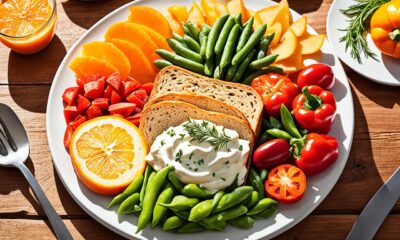
 id5 months ago
id5 months agoKesra Sebagai Pilihan Pangan Sehat untuk Keluarga
-

 id5 months ago
id5 months agoRahasia Sehat dengan Olahraga Rutin Anda
-

 News5 months ago
News5 months agoThe Heartbreaking Story of Tim Chapman's Wife


























